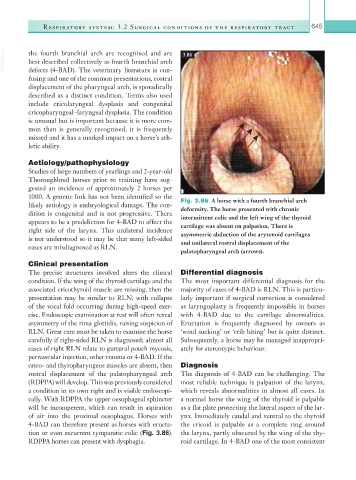Page 670 - Equine Clinical Medicine, Surgery and Reproduction, 2nd Edition
P. 670
Respir atory system: 3.2 Surgical conditions of the respir atory tr act 645
VetBooks.ir the fourth branchial arch are recognised and are 3.86
best described collectively as fourth branchial arch
defects (4-BAD). The veterinary literature is con-
fusing and one of the common presentations, rostral
displacement of the pharyngeal arch, is sporadically
described as a distinct condition. Terms also used
include cricolaryngeal dysplasia and congenital
cricopharyngeal–laryngeal dysplasia. The condition
is unusual but is important because it is more com-
mon than is generally recognised, it is frequently
missed and it has a marked impact on a horse’s ath-
letic ability.
Aetiology/pathophysiology
Studies of large numbers of yearlings and 2-year-old
Thoroughbred horses prior to training have sug-
gested an incidence of approximately 2 horses per
1000. A genetic link has not been identified so the
likely aetiology is embryological damage. The con- Fig. 3.86 A horse with a fourth branchial arch
dition is congenital and is not progressive. There deformity. The horse presented with chronic
appears to be a predeliction for 4-BAD to affect the intermittent colic and the left wing of the thyroid
right side of the larynx. This unilateral incidence cartilage was absent on palpation. There is
is not understood so it may be that many left-sided asymmetric abduction of the arytenoid cartilages
cases are misdiagnosed as RLN. and unilateral rostral displacement of the
palatopharyngeal arch (arrows).
Clinical presentation
The precise structures involved alters the clinical Differential diagnosis
condition. If the wing of the thyroid cartilage and the The most important differential diagnosis for the
associated cricothyroid muscle are missing, then the majority of cases of 4-BAD is RLN. This is particu-
presentation may be similar to RLN, with collapse larly important if surgical correction is considered
of the vocal fold occurring during high-speed exer- as laryngoplasty is frequently impossible in horses
cise. Endoscopic examination at rest will often reveal with 4-BAD due to the cartilage abnormalities.
asymmetry of the rima glottidis, raising suspicion of Eructation is frequently diagnosed by owners as
RLN. Great care must be taken to examine the horse ‘wind sucking’ or ‘crib biting’ but is quite distinct.
carefully if right-sided RLN is diagnosed; almost all Subsequently, a horse may be managed inappropri-
cases of right RLN relate to guttural pouch mycosis, ately for stereotypic behaviour.
perivascular injection, other trauma or 4-BAD. If the
crico- and thyropharyngeus muscles are absent, then Diagnosis
rostral displacement of the palatopharyngeal arch The diagnosis of 4-BAD can be challenging. The
(RDPPA) will develop. This was previously considered most reliable technique is palpation of the larynx,
a condition in its own right and is visible endoscopi- which reveals abnormalities in almost all cases. In
cally. With RDPPA the upper oesophageal sphincter a normal horse the wing of the thyroid is palpable
will be incompetent, which can result in aspiration as a flat plate protecting the lateral aspect of the lar-
of air into the proximal oesophagus. Horses with ynx. Immediately caudal and ventral to the thyroid
4-BAD can therefore present as horses with eructa- the cricoid is palpable as a complete ring around
tion or even recurrent tympanitic colic (Fig. 3.86). the larynx, partly obscured by the wing of the thy-
RDPPA horses can present with dysphagia. roid cartilage. In 4-BAD one of the most consistent

